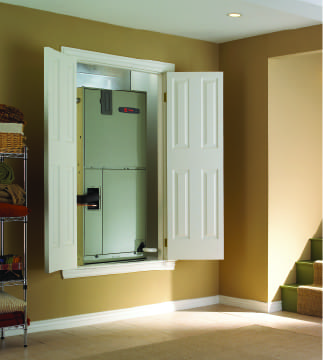The difference between air handlers and furnaces is simple. Air handlers move air that is heated or cooled by an exterior source, whereas furnaces create heat and move it elsewhere. However, there are other ways in which they are distinct from each other. As a matter of fact, you can even say that a furnace is an air handler itself, with an added design for creating heat.
How Do Air Handlers Function?
In a nutshell, an air handler moves cooled-off or heated-up air through a system using forced air. A forced-air system incorporates a powerful fan, called a blower, which circulates this cooled or heated air throughout your home using ductwork. The air handler moniker comes from the name of the cabinet that houses the blower, and it fits well since the blower, in essence, handles the air.
An air handler functions in a particular way that is quite different from a regular furnace. First, it circulates air back and forth through grates and ducts. It then cools or heats the air using an indoor coil that is a crucial part of the unit.
As a heater, the air handler works as part of a heat pump system. The refrigerant in an outdoor coil captures outside heat and brings it inside. When this warm refrigerant enters the indoor coil in the air handler, the coil becomes very hot. The blower then pulls cold air into the unit and passes it over the warmed coil, heating it up. This heated air is then expelled through your ducts and the vents in each room of your home.
The physics of the unit are reversed in order to cool your home when it is in air conditioner mode. The blower pulls damp, warm air in through specific ducts that are referred to as “return ducts.” Once this air arrives in the air handler, it travels over an indoor coil, which is filled with refrigerant that cools it significantly by absorbing the heat it contains. Any moisture is then condensed onto the coil and away from the air, which makes the surrounding atmosphere feel much more comfortable. The blower will then force the dry, cool air through what is referred to as “supply ducts,” and then through your vents into your home. At the same time, the heated refrigerant travels to the outdoor heat pump and into a coil that is similar to a radiator. The heat is then transferred from the refrigerant and released.
How Do Furnaces Work?
Furnaces create heat from scratch rather than pulling it from the surrounding air. There are three different types of furnaces available: oil furnaces, gas furnaces, and electric furnaces. Gas furnaces are quite common no matter what part of the country you live in, but oil furnaces can be found more often in the Mid-Atlantic states and New England since natural gas is typically not as readily available there as it is elsewhere. Electric furnaces rely on the principle of electric resistance for creating heat. Since they are far from efficient, they work best in generally warmer climates, such as in the South, where heaters are only necessary intermittently.
Furnaces use blower fans, not unlike air handlers, and when the thermostat is set to a temperature higher than that of the room, a gas or oil furnace will begin to burn fuel to reach the requested setting, while an electric furnace, not unlike a space heater, will turn on its heating coil. The electric coil or the combustion box/heat exchanger will heat up, and the blower will turn on, pulling surrounding colder air into the furnace to be heated. This hot air will then be pushed out into your ducts and through the grates around your house.
The furnace will then stop making heat once the temperature matches your desired thermostat setting. That said, the blower will run until all built-up heat has been pushed out of your furnace.
How Do Air Handlers and Furnaces Differ?
Well, the major difference is that air handlers do not create heat while furnaces do. That is because air handlers simply distribute heat that is created by a heat pump, which is a completely separate appliance. However, there are areas of the United States where heat is almost never needed, and in these places, an air handler can be installed without a heat pump.
Another distinction between the two heating systems is that all air handlers that distribute heat need air conditioning coils and heat pumps in order to warm your home. This is because they do not produce heat themselves, as furnaces do. They need the coil to redistribute heat that is found outdoors. Conversely, furnaces only contain coils if they are a part of a larger central air conditioning and heating system.
How Are Air Handlers and Furnaces the Same?
Of course, both furnaces and air handlers contain blower fans that circulate all cooled or heated air throughout your ducts and through your grates. They are both manufactured by all major brands and HVAC companies, including Rheem, Trane, Goodman, Lennox, and Carrier. Many air handlers are sold with heat pumps, and many furnaces are actually split systems paired with air conditioners. Both heating systems are also controlled by thermostats.
There are also different sizes of both furnaces and air handlers available. The size of your system is completely dependent on the needs of your home, including airflow. After all, it cannot be disputed that the larger the area is that your heating, the bigger your heating system, whether it is an air handler or a furnace, should be. This is due to having to move more cubic feet of air per minute overall. And, even if you have a smaller home, if it contains larger ducts, a bigger blower will be needed to create the perfect amount of air pressure in order to move air effectively. A well-trained HVAC professional can help you assess what size of furnace or air handler is necessary for your ductwork capacity and house size.
Both furnaces and air handlers also come in single-speed and variable-speed models. Single-stage heat pumps and air conditioners, as well as single-stage furnaces, use single-speed blowers, while two-stage and modulating heat pumps and furnaces utilize variable-speed blower motors.
Which Heating System Is Better for You?
The answer to this question is all dependent on your particular home and climate. Heat pumps and air handlers work well in climates that are warm and humid and don’t really require significant heating for long periods. They also offer lower energy costs for people who don’t need to purchase heftier systems. That said, homes in colder areas are not easily heated by heat pump systems, since they are unable to collect enough heat from the outside in such climates. That is why furnaces may be better options in such places.
In conclusion, there are plenty of advantages to incorporating either heating system in your home. However, if you are really unsure about which system is best for you and your home, Charleston Heating and Air can help. We are your North Charleston, South Carolina HVAC experts, and we can help you decide which unit you should consider for your home, as well as install it for you and provide repairs and maintenance when needed. We also offer plumbing and electrical services. Contact us today for more information or to set up an appointment.

